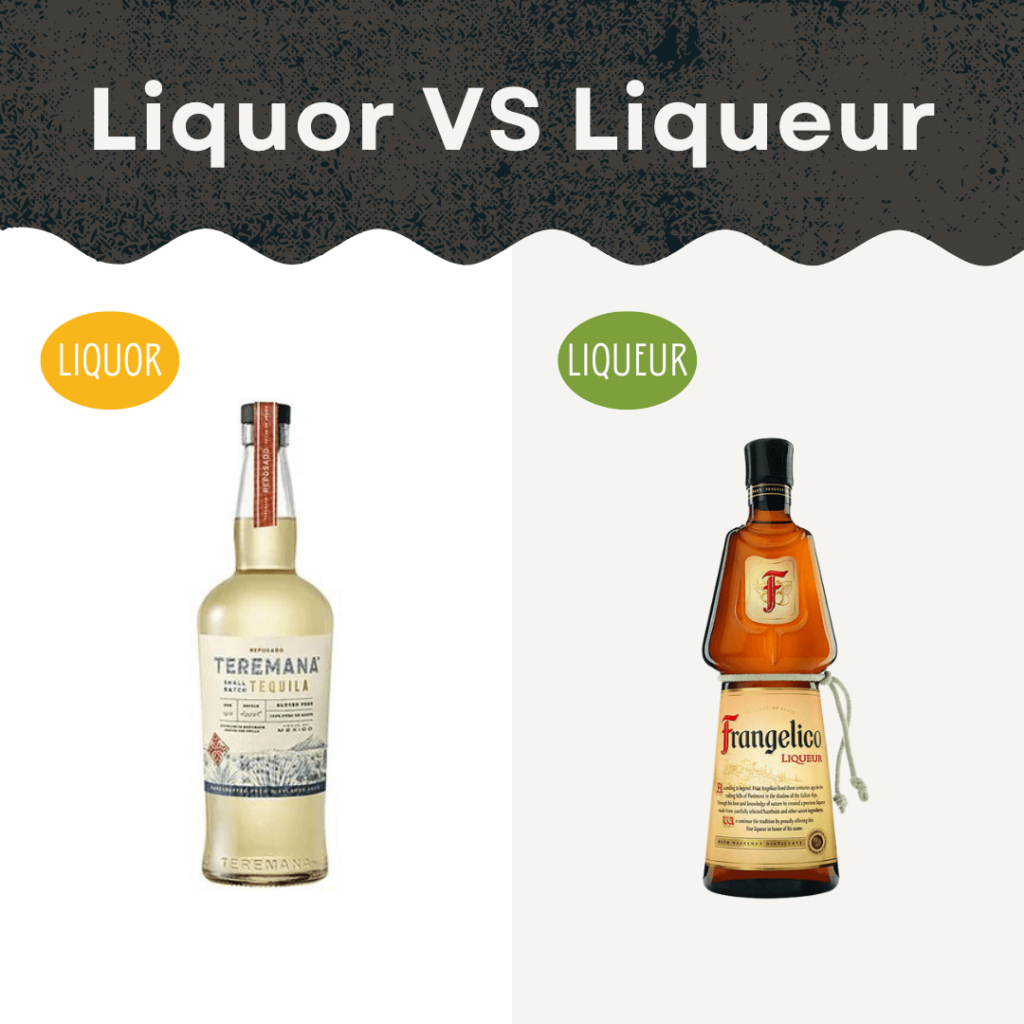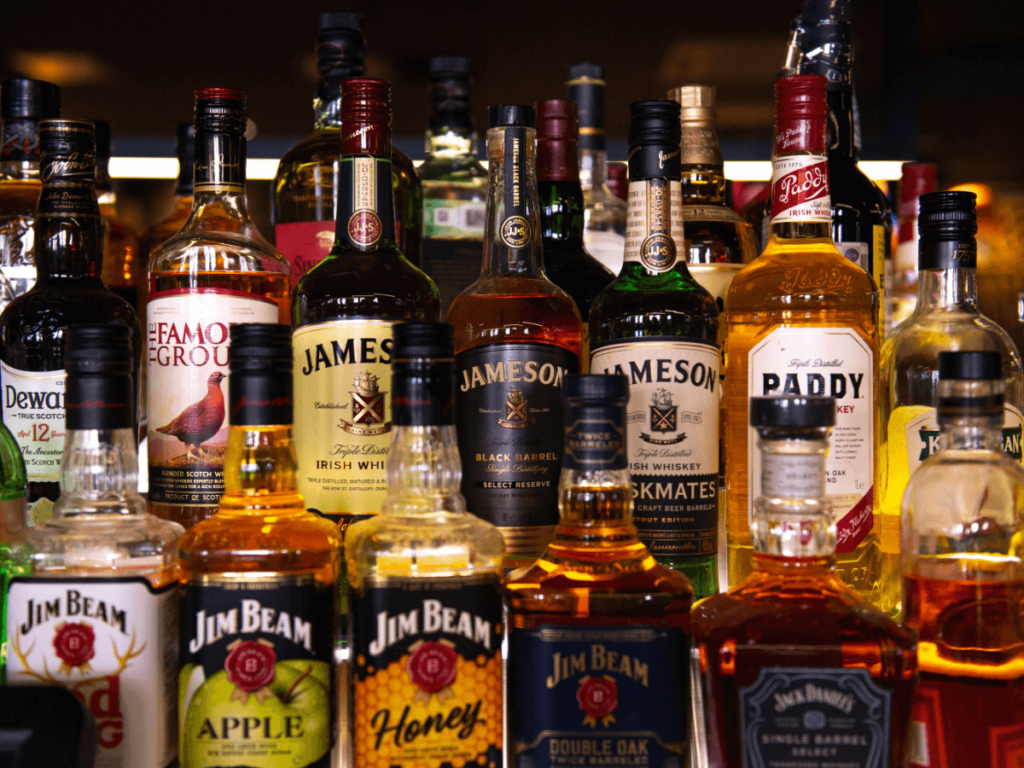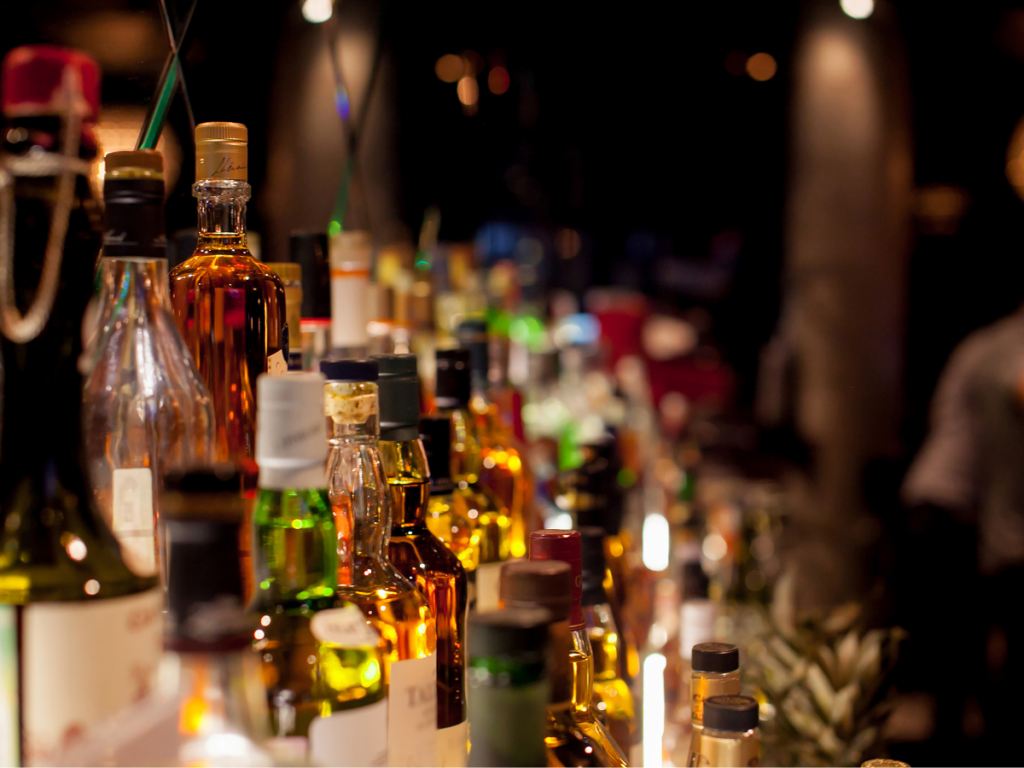Provavelmente já teve dificuldades em abrir uma garrafa sem um abre-garrafas. Bem, as suas dificuldades...
Licor VS Licor: Qual é a diferença
Today we’re talking about two types of alcoholic drinks that often get confused – liquor and liqueur.
You’ve definitely heard of both before. From vodka and whiskey to Bailey’s and Kahlua, these strong spirits are staples behind most bars and can totally transform a cocktail. Or just be sipped on their own!
Mas mesmo que pareçam muito semelhantes e sejam bebidas alcoólicas para adultos, o licor e o licor são, na verdade, bem diferentes.
I didn’t really understand the exact differences myself until recently!
So in this article, we’ll break down what sets liqueurs and liquors apart, look at some popular varieties of each, and go over how you can use them.
Licor VS licor: Qual é a diferença
First off – pronunciation. I’ve heard both liquor and liqueur incorrectly pronounced many times. Just to be clear:
Liquor is pronounced “lick-er.”
Liqueur is pronounced “luh-kur.”
Got that? Great! With that out of the way, let’s jump right into understanding these terms.
At a basic level, liqueurs and liquors are both alcoholic beverages that contain distilled spirits. But liqueur has added flavorings like fruits, cream, herbs, nuts, spices, or even coffee or chocolate. The extra ingredients make them sweeter and more syrupy, while liquors don’t contain added sugar or flavors.
Faz sentido até agora? Para recapitular a distinção principal: Licor refere-se a bebidas destiladas puras, como vodka, rum, uísque, etc. O licor usa licor como base, mas tem sabor extra adicionado.
Now you might be wondering – how did these flavorful liqueurs come about? And what exactly IS the process of distillation that liquors go through? Good questions! Let’s explore those next.
História e Produção
Na verdade, os humanos destilam bebidas alcoólicas há milhares de anos! Algumas das primeiras bebidas destiladas foram provavelmente criadas por volta do século XII na Itália e na França. Naquela época, pensava-se que muitos licores tinham propriedades medicinais ou poderes curativos especiais. Com o tempo, receitas e técnicas se espalharam pela Europa, Oriente Médio e Ásia.
Today, we of course know liquor more for its intoxicating effects than any health benefits. But fun fact – even in the 1500-1600s, liqueurs were still largely used as medicine rather than recreational drinks. Their viscous texture and concentrated herbal flavors made liqueurs sort of a sweetened cure-all tonic. It wasn’t until hundreds of years later that they became popular as after-dinner drinks or cocktail mixers.
Seja para fazer licor básico ou licor aromatizado, o primeiro passo é a fermentação. Isso significa expor açúcares e amidos ao fermento, que os converte em álcool. A fermentação é essencial não apenas para bebidas, mas também para coisas como vinho, cerveja, pão e até iogurte!
Next comes the truly defining process – distillation. This involves heating up fermented liquids to the point that alcohol evaporates, then collecting and cooling those alcohol vapor droplets. Repeating this redistillation makes the end product higher and higher proof.
What’s left is concentrated ethanol alcohol alongside various organic compounds that provide taste, aroma, and complexity. The more times it’s redistilled, the purer and cleaner the liquor becomes. Vodka is one of the most extremely distilled spirits, getting up to 95% ABV!
Outros licores como whisky e brandy passam por condições de destilação muito específicas para realçar os sabores desejados. Mudanças de fatores como temperatura, formato do equipamento, ingredientes fermentados e tempo de envelhecimento conferem a diferentes tipos de licores clássicos, como rum, gim e tequila, seu caráter distinto.
Now let’s go back to liqueurs. As we learned already, they start with a fermented and distilled base liquor. The extra step is infusing, mixing, and sweetening it with anything from fruits, nuts, spices, herbs, flowers or bark to chocolate, caramel, honey, dairy cream, eggs, and more.
Hoje existem milhares de licores exclusivos com infinitas combinações de bases e aromas de licores. Algumas receitas de licores foram segredos bem guardados por gerações!
Variedades populares de
Alright, now that we understand how they’re made, let’s go through some popular types of liquor and liqueur along with what makes them special. We won’t have time to cover them all, but these are definitely the heavy hitters you’ll encounter at the bar or liquor store.
Tipos de licor
Começando pelas bebidas alcoólicas, as principais categorias são:
- Vodka: Typically made from grains like wheat, rye, or potatoes. This neutral spirit becomes a “blank canvas” for both cocktails and infused flavor varieties like lemon, vanilla, or cinnamon vodka. Popular brands include Smirnoff, Absolut, Tito’s, and Ketel One.
- Rum: Feito a partir de subprodutos da cana-de-açúcar, como melaço ou suco fresco. As variedades de rum escuro e claro adicionam doçura e personalidade às bebidas tiki e coquetéis de verão. Capitão Morgan, Bacardi, Malibu e Myers são alguns best-sellers.
- Tequila: Mexico’s most iconic spirit comes from the agave plant. From mixed drinks like the Tequila Sunrise to salt-rimmed shots, this liquor with herbaceous flavors makes the party more fun. Patron, 1800, Casamigos, and Jose Cuervo rule the blue agave game.
- Uísque: Usually distilled from fermented grain mash including varieties like corn, barley, rye or wheat. Aged in wooden barrels for complexity. Bourbon, Scotch, Irish, and Tennessee styles like Jack Daniel’s, Jameson, and Crown Royal define whiskey’s popularity.
- Gin: Juniper-flavored liquor made from neutral fermented grains. The juniper berry’s bracing pine quality refreshes cocktails like the Martini and Gin and Tonic. Top brands are Tanqueray, Aviation, Bombay Sapphire, and Hendrick’s.
- Conhaque: Criado pela destilação de sucos de frutas como maçãs ou uvas em uma aguardente suave e depois envelhecido em carvalho. Tipos famosos são Cognac e Armagnac da França. Hennessy, Courvoisier e Martell têm prestígio.
Tipos de licores
Those cover the major liquor bases you’ll encounter. Now what about delicious liqueurs? Some of the main liqueur varieties are:
- Fruta: Mostre sabores doces como amora, laranja, pêssego, melão ou frutas vermelhas. Esses cordiais conferem um sabor festivo aos coquetéis. Exemplos são Cointreau, Grand Marnier, Chambord e limoncello.
- Café: Misturas como Kahlua e Tia Maria tornam as bebidas depois do jantar, como o Irish Coffee, ainda mais indulgentes. Misturar café e destilados cria uma combinação reconfortante, mas sofisticada.
- Creme: Creamy liqueurs have an airy, velvety texture thanks to added dairy or eggs. Bailey’s Irish Cream and Amarula fruit cream give dessert cocktails a decadent edge.
- Chocolate: Para o deleite final, licores de chocolate como Godiva e Tiramisu satisfazem os desejos em forma de bebida. A profundidade rica e quente os torna um complemento natural aos martinis.
- Ervas: Esta categoria abrangente de sabores abrange licores feitos de ervas, flores, sementes, especiarias, cascas de árvores, raízes, baunilha e muito mais. Essas infusões botânicas complexas incluem Chartreuse, St. Germain, Benedictine, Drambuie e Jagermeister.
- Noz: Toasted nut flavors give these liqueurs full body and subtle sweetness. Frangelico’s hazelnut and Disaronno’s almond profiles make them mixers that instantly elevate fall and winter drinks.
Of course we’ve still just barely scratched the surface of all the liqueurs out there today, not to mention the rising tide of creative craft liquor distilleries. But knowing this lineup will help you understand menus and recipes much better.
Usando licores e licores
Now you know what makes liqueurs different from straight liquor. So how do bartenders actually use them in drinks? And what’s the best way to drink them when you’re not mixing cocktails?
Liquors are extremely versatile thanks to their neutral flavor. As “base spirits,” they build the foundation of all kinds of cocktails balancing stronger boozy impact with other sweet, sour, or herbal elements. They can also be simply sipped neat, over ice, or with a basic mixer like soda, juice or tonic water.
Vodka’s mild profile suits chilled shots, refreshing mixed drinks like vodka soda or Screwdriver, and picks up other flavors easily in infusions. Gin plays nicely with lighter mixers like tonic, citrus, elderflower, or cucumber to round out its juniper bite in G&Ts and gimlets.
Whiskey’s complexity shines when drunk straight or on the rocks but also adds depth to an Old Fashioned or Manhattan when combined with bitters, sugar, and other liquors. And tequila adds Southwestern flair to spice up margaritas, sangrias, and spicy-smoky combinations.
Em comparação com as bebidas alcoólicas multiuso, os licores têm utilizações mais específicas devido à sua natureza muito doce e forte. Você só precisa deles em pequenos salpicos para causar um impacto perceptível. Muito mais do que meia onça irá rapidamente superar outros ingredientes.
Classicamente, os licores apareciam no final de banquetes extravagantes na Europa aristocrática para ajudar na digestão. Hoje, coquetéis de café após o jantar, como Irish Coffee e Espresso Martinis, destacam os licores de maneira semelhante. Sua riqueza compensa o café amargo por uma indulgência doce.
Nos coquetéis, os licores preenchem a lacuna entre as bases do licor e os sabores suplementares. Veja como o triple sec, um licor de laranja doce, combina tequila com suco cítrico em uma Margarita. Ou como a cereja Heering se casa tão bem com conhaque e vermute em Manhattan.
Bittersweet herbal liqueurs add intrigue to simple two-ingredient combos too – think Campari and gin or Aperol and prosecco. Even just adding a splash of one to a dram of straight whiskey makes for a warming, gently enhanced take on a classic spirit.
Thanks to sweeter flavors that offset liquor’s punch, many liqueurs also make great introductory alcohols for those new to drinking too. Berries and cream Baileys over ice proves far more approachable than harsh whiskey or vodka to start with.
E a última maneira pela qual muitos apreciam licores é simplesmente como uma dose gelada ou um gole decadente. Servir Drambuie com nozes e especiarias ou Kahlua puro com café deixa seu açúcar suavizado e com intensidade concentrada brilhar.
Conclusão
We’ve covered quite a bit of ground going through all things liquor and liqueur! To recap, the key points about each are:
Licor:
- Refere-se a qualquer bebida destilada com álcool tipicamente 40 a 55% ABV
- Feito através de fermentação e destilações múltiplas para pureza
- Inclui vodka, rum, tequila, gin, conhaque, uísque
- Versátil para beber puro ou misturar em coquetéis
- Confere sabor básico de destilado, mas não adiciona doçura
Licor:
- Começa com uma base de licor destilado e sabores adicionados
- Geralmente reduz o álcool em torno de 15-30% ABV
- Inclui estilos de frutas, café, creme, nozes, especiarias e chocolate
- Fornece rica doçura, viscosidade e complexidade floral/ervas
- Mais frequentemente usado em pequenas quantidades para realçar coquetéis
To share a memorable analogy I once heard: Think of liquor as the canvas and liqueur as the paints. You start with blank neutral spirits, then splash in intensely vibrant liqueurs for bursts of color…transforming your basic canvas into a vivid, flavored cocktail masterpiece!
Além de seus usos na mixologia, os licores e licores também têm uma história super fascinante. Examinamos como eles evoluíram de tônicos de ervas medicinais séculos atrás até os principais blocos de construção de coquetéis que são hoje. Algumas receitas de licores ainda são segredos bem guardados depois de centenas de anos!
Se você prefere uísque puro, adora uma desculpa para beber sobremesa com seus Baileys no gelo ou brinca de mixologista caseiro agitando novas misturas, espero que isso tenha lhe proporcionado uma análise útil de licor versus licor para enfeitar seu conhecimento de destilados!
We just covered a whole lot of information, but don’t feel overwhelmed. Getting familiar with some go-to liquor brands you enjoy and experimenting with liqueur flavors can be super fun. No need to learn all their nuances in just one night!
When starting out, sweeter liqueurs tend to be more mixable for beginners too compared to harsher straight liquors. Feel free to start slowly sipping rather than shooting if that’s needed to acquire the taste!
No right or wrong way here – just discover what types of liquor and liqueur suit your preferences.
Obrigado por assistir para explorar este tópico de curiosidade sobre coquetéis comigo! Até a próxima, felicidades!






